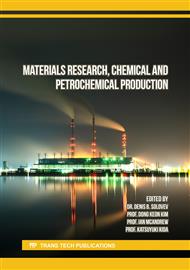[1]
T.A. Malinovskaya, Suspension Separation in the Organic Synthesis Industry, Moscow: Khimiya, 1971, p.236.
Google Scholar
[2]
V.A. Zhuzhikov, Filtration, Theory and practice of separation of suspensions, Moscow: Goshimizdat, 1971, p.438.
Google Scholar
[3]
O.L. Bruk, Filtration of Coal Suspensions, Moscow: Nedra, 1978, p.271.
Google Scholar
[4]
M.I. Beilin, Theoretical basis of the dehydration process, Moscow: Ugletekhizdat, 1969, p.240.
Google Scholar
[5]
I.N. Beloglazov, V.O. Golubev, O.N. Tikhonov, Yu. Kuukka, Yaskelainen, Ed., Filtration of technological pulps, Moscow: Ruda i metally, 2003, p.320
Google Scholar
[6]
V.I. Salamatov, Sludge filters slurry dewatering and flushing, Irkutsk: Irkutsk State Technical University, 2007, p.131.
Google Scholar
[7]
N.K. Skobeev, Filtering materials, Moscow: Nedra, 1978, p.200.
Google Scholar
[8]
E.N. Tyuftin, Hydrometallurgical pulp washing, Moscow: Metallurgia, 1970, p.222.
Google Scholar
[9]
Z.F. Semina, On the overgrowth of filter fabrics Izv. Universities, Non-ferrous metallurgy. 2 (1984) 22-23.
Google Scholar
[10]
E.M. Eisenstein, Bottle waste in textiles, Fibre Chemistry. 5 (2015) 3-8.
Google Scholar
[11]
N.N. Machalova, I.I. Radionov, Development Issues of the Russian Chemical-Fiber Industry Fibre Chemistry. 4 (2015) 3-14.
Google Scholar
[12]
V.I. Salamatov, S.N. Golovachev, Yu.N. Gornov, Life cycle of filter membranes Siberian scientific branch bulletin of Russian, Academy of Natural Sciences. 2(55) (2016) 88-95.
Google Scholar
[13]
K. Preda, Getextile cu continut de fibre recuperate din material textile refolosibile, Ind. Text. 57(2) (2006) 104-106.
Google Scholar
[14]
A.V. Dedov, V.G. Nazarov, Processed nonwoven needlepunched materials with increased strength, Fibre Chemistry. 2 (2015) 53-58.
DOI: 10.1007/s10692-015-9649-2
Google Scholar
[15]
A.V. Dedov, E.S. Bokova, V.A. Ryzhkin, Production of nonwoven needlepunched material with increased stretch resistance, Fibre Chemistry. 4 (2013) 221-223.
DOI: 10.1007/s10692-013-9516-y
Google Scholar
[16]
O.V. Goloveshkina, I.Y. Shipovskii, S.N. Bondarenko, N.A. Keibal, V.F. Kablov, Development of low-shrinkage polyethylene fibers Fibre Chemistry, vol. 46(4) (2014) 254-456.
DOI: 10.1007/s10692-014-9600-y
Google Scholar
[17]
K.A. Singha, Review on Coating & Lamination in Textiles: Processes and Applications American, Journal of Polymer Science. 2(3) (2012) 39- 49.
DOI: 10.5923/j.ajps.20120203.04
Google Scholar
[18]
J. Homutes, A. Grigoriu, M. Rosca, Tratamen te aicaline si termice ale acetatilor de celuioza, Bul. Inst, pulitechn. lasi. 1-4 (1984) 45-50.
Google Scholar
[19]
O.O. Erofeev, T.E. Voloschik, Yu.K. Naganovskii, Z.Yu. Kozinda, Influence of operational factors on properties of heat-resistant nonwoven filter materials, Fibre Chemistry. 2 (2013) 94-97.
DOI: 10.1007/s10692-013-9487-z
Google Scholar
[20]
E.M. Aizenshtein, Russian output of Polyester Fibres in 2017 Composite World Fibre Chemistry. 3(78) (2018) 26-31.
Google Scholar


